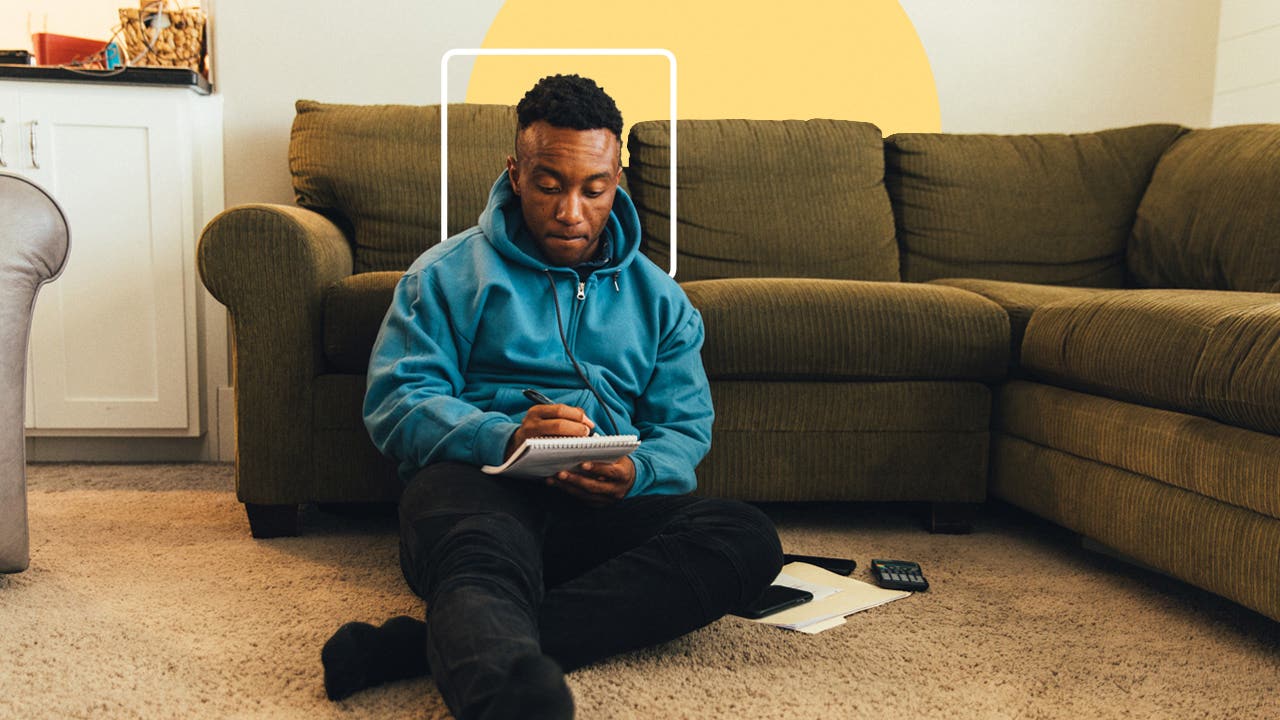Guide to saving money to move out




Key takeaways
- Living on your own can get extremely expensive, especially if you’re not used to being financially independent.
- There are ways to make sure you’re financially ready to move out so you aren’t drowning in debt.
If you’ve graduated from high school or college and are still living at home, you’re not alone. More than 2 in 5 (42 percent) millennials currently receive, or have received, ongoing financial assistance from their parents/guardians at age 23 or older, according to Bankrate’s Financial Independence Survey.
Nearly two-thirds (64 percent) of millennials and 55 percent of Gen Zers said they delayed a financial milestone due to the state of the economy in a Bankrate’s Delayed Financial Milestone Survey. Plus, many are faced with student debt.
Still, this doesn’t mean the outlook is hopeless. It just means that for young Americans to overcome these hurdles and strike out on their own (either by renting solo or buying a home), saving, investing and budgeting will be key. Do you want to make the dream of moving out of your parents’ home a reality? Consider this your guidebook.
How to save up to move out
Whether you aim to buy a home or rent an apartment, you’ll need a healthy amount of savings to make it happen. Rentals come with deposits, fees and other expenses, while buying a home requires a hefty down payment plus closing costs. The average monthly mortgage payment nationwide is about $2,200 per month.
To meet your savings goals, begin by paying down any existing debts. Since you’re living at home and likely have fewer expenses, try to funnel a good chunk of your current income toward paying off student loans and any other high-interest debts while there. The quicker you can pay down these balances, the easier and faster you’ll be able to save for your own place. As a nice little bonus, paying down these debts can also help your credit score — which can help with both a rental application and a mortgage loan.
Here’s how to kickstart your savings:
1. Open a savings account
First and foremost, you’ll want a high-yielding savings account, as this will earn you more on what you save. Current savings rates are high, at around 5 percent in some cases, which provides an excellent opportunity to maximize your earnings. Compare different banks and credit unions to find the best rates available. Online institutions often offer more competitive rates compared to traditional, brick-and-mortar banks.
2. Increase your income
Earning income is essential in paying for both essentials (housing, food, bills) and non-essentials (entertainment, dining out). But more than that, you’ll need to increase your income to build up your savings.
Because of that, consider boosting your income as much as you can. This could be increasing your hours at your main job, picking up a side-hustle or freelancing.
3. Create a personal budget
Minimizing your expenditures will free up more cash to put toward savings. As a general rule, commit to never spending more than you make (this will only result in more debt), and start creating budgets for individual expenses.
Make sure you know how much you need to save, too, as this will help you budget your funds and determine a timeline for your goals. This savings calculator can help you pinpoint exactly how much you should save daily and monthly in order to make your move a reality.
4. Build up your credit
Regardless of whether you’ll be buying or renting, your credit will play a role in your move — as well as how much it will cost you. If you want to have your pick of properties and minimize your costs, having a prime credit score can help.
Credit scores are determined by a number of factors related to loans and credit, including payment history, utilization of credit, credit history and new credit inquiries.
Paying off your debts will give your credit score a nice boost, but there are other ways you can improve that number as well:
- Get a credit card (if you don’t already have one), and keep your credit utilization ratio low. Commit to paying it off in full and on time every month. Use this credit card to pay for items you were already paying for, such as groceries and a cell phone bill, as opposed to racking up debt on unnecessary purchases.
- Become an authorized user on your parents’ account or the account of someone else with an established credit history.
- Pull your credit report from Experian, TransUnion or Equifax, just to be safe. If there are any errors or inaccuracies, report them and have them addressed. It could mean a serious boost in score once corrected.
Remember, once you’ve paid an account balance off, don’t close it out. Credit history is a big factor in your score, so keeping these older accounts on your record is crucial.
Costs of moving out
It’s easy to think of the major expenses when you move out, such as monthly rent or a mortgage payment. But there are other charges you might not have considered yet.
For renters, you may need to hand over your first and last month of rent, along with a security deposit, when you sign a lease agreement. Some places charge an application fee, which covers the charge to pull your credit, do a background check, or other administrative tasks. These fees vary and aren’t always included, but might be, depending on where you are looking to live.
There are also other related move-in costs, like:
- Moving costs (such as hiring movers or renting a moving truck, along with moving supplies)
- Water, electricity, gas
- Phone and internet
- Registration, like updating your driver’s license, banking information, car and other official information with your new address
- Furniture
- Supplies
- Decor
- Bedding
- Technology (such as a computer and TV, if you don’t already have those of your own)
- Food
- Pet fees (if applicable)
In some cases, like the utilities, you might have a fee to turn on those services, which could cost you even more in upfront fees.
- Of U.S. parents with children over the age of 18, 68 percent say they’ve made a financial sacrifice to help their adult children with money. (Bankrate)
- Of Gen Z, 30 percent rent from a landlord, while 39 percent of millennials rent from a landlord. (Bankrate)
- Most young adults (62 percent of young millennials and 63 percent of Gen Z) say homeownership is part of their American dream, yet 73 percent of all aspiring homeowners say they can’t afford it. (Bankrate)
- About a quarter (26 percent) of millennials said they delayed buying a house due to economic concerns. (Bankrate)
- Many young adults are crippled by student debt: Those ages 25 to 34 have about $482.4 billion in student loan debt, and adults under 24 — many of whom are still in college — already have $104.2 billion in student loan debt. (Studentaid.gov)
- While the portion of young adults (ages 18 to 29) living with their parents peaked at 52 percent during the height of the pandemic, data from a year later showed that about a third (33 percent) of young adults ages 18 to 34 still were living with parents. (Pew Research Center)
Saving up to rent
To start saving for your future rental, research rent costs in your area. A general rule is limiting rent costs to no more than 30 percent of your monthly take-home pay. However, less money spent on rent means more money available for short-term and long-term saving goals. Once you’ve determined what your rent will be, add another 30 percent to that to account for living expenses. This will include things like:
- Water
- Electricity
- Gas
- Renter’s insurance
- Internet service
You should also see whether the rental units you’re considering will require a deposit. Many landlords ask for security deposits and first and last months’ rent. There may also be a pet deposit, if you’re bringing a furry friend. There are also moving costs to consider: packing materials, moving truck rentals or moving company fees.
Use a spreadsheet to tally up all these expenses and determine:
- what your move will cost you upfront and
- what the rental will cost on a monthly basis
Aim to save up at least your upfront costs and three months of rent, plus expenses, before leaving the nest.
Saving up to buy
With 78 percent of U.S. adults saying homeownership is part of the American dream, according to Bankrate’s Home Affordability Report, it might be an important part of your future plans. But if you’re planning to buy a place rather than rent, there are many more associated homeownership costs you’ll need to save for.
Buying a house requires a down payment — almost like a deposit on the home. The total cost of a down payment varies depending on your mortgage loan, the home you’re purchasing and your credit, but you can generally expect to pay anywhere from 3 percent to 20 percent of the total purchase price. On a $200,000 home, for example, that would mean a down payment of $6,000 to $40,000.
These numbers might seem jaw-dropping at first glance, but they’re not necessarily out of reach. You’ll need to consider the following:
- Determine your estimated down payment. Consider speaking to a loan officer at a local bank or mortgage lender for guidance on this. Or play around with Bankrate’s down payment calculator.
- Nail down your timeframe. When are you looking to buy? This will help you determine how much you’ll need to save each month to get there.
- Budget toward those savings. Once you know what you need to save on a monthly basis, you can start budgeting out your expenses to free up any extra cash.
- Automate your savings. Consider setting up automatic savings deposits (from your paychecks or checking account) or using a savings app to keep your savings goals on track.
- Bank those windfalls. Getting a Christmas bonus? A tax refund? An inheritance? A birthday check? Dedicate that chunk of cash — in full — to your house fund.
- Build in flexibility. Sometimes extra costs come up, or you bring in less money than you thought. Make sure you have a little cushion (both financially and time-wise) in the event something goes off course.
Money tip: Keep in mind that the down payment isn’t your only cost if you’re going to buy a home. You’ll also have closing costs, which usually account for anywhere from 2 to 5 percent of the total loan balance, as well as fees for inspections, appraisals, insurance and more. Many lenders will also ask that you have enough cash to cover at least 3 to 6 months of mortgage payments, too.
Other options to save on costs
If you want to buy a home but the costs seem too daunting, there are several other approaches you can take:
- Bring in a roommate to help share the costs of the house with you. This will help both upfront and on a monthly basis.
- Consider a home that’s on the smaller side, like a townhome or condo unit. These typically come with much smaller down payments, mortgage costs and, in many cases, monthly utility costs as well.
- Look into low-down payment loans. VA and USDA loans require zero down payment if you’re eligible, and FHA and conventional loans require just 3 percent to 3.5 percent down. There are also down payment and closing cost assistance programs that might be able to offset the upfront costs of buying a house.
— Freelance writer Dori Zinn contributed to an update to this article. Former Bankrate writer René Bennett updated an earlier version of this story.
Why we ask for feedback Your feedback helps us improve our content and services. It takes less than a minute to complete.
Your responses are anonymous and will only be used for improving our website.




